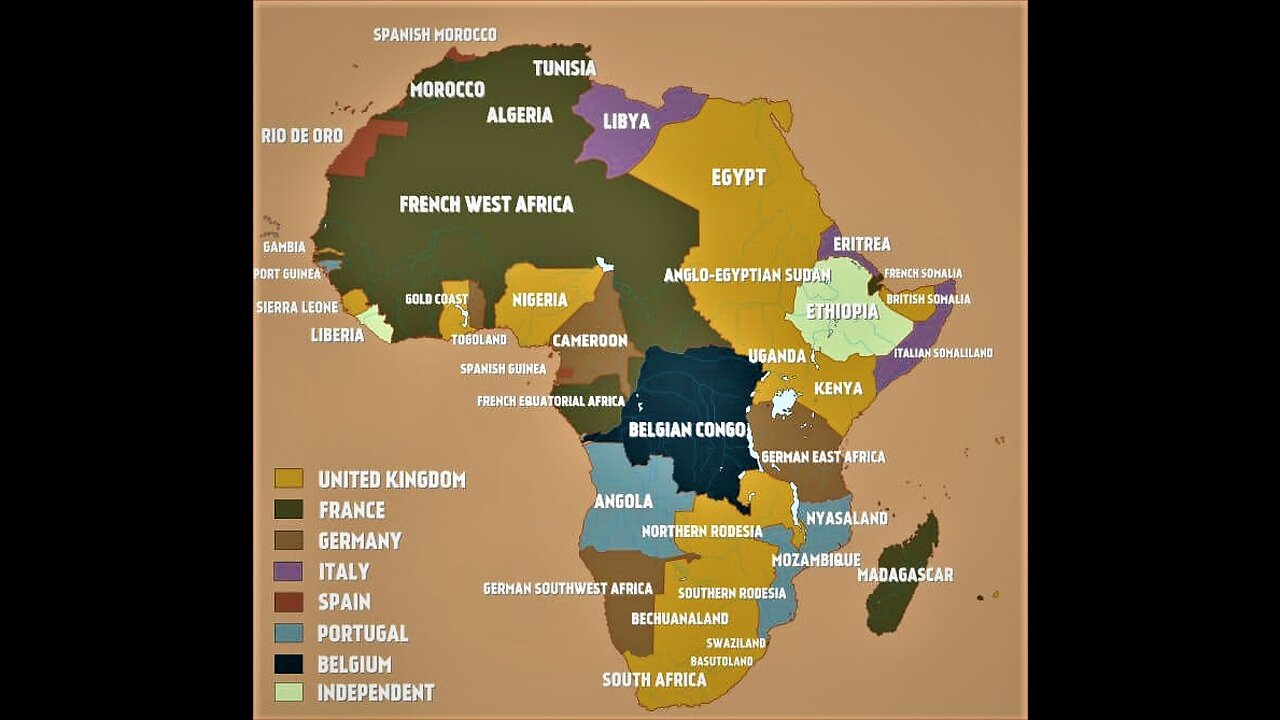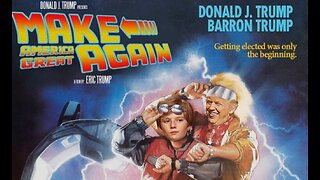Premium Only Content

European Colonies before WW1 - White History Month
The map above shows how the African continent was divided in 1914 just before the outbreak of World War I. By this time, European powers controlled 90% of the continent with only Abyssinia (Ethiopia) and Liberia retaining independence.
When war broke out, each of these colonies were not only expected to help their respective European occupier with manpower and raw materials, but many actually became theatres of war in their own right.
The population breakdown by each power was roughly as follows:
Britain had 30% of the continent’s people in its colonies.
France had 15%.
Portugal had 11%.
Germany had 9%.
Belgium had 7%.
Italy had 1%.
Yet, the Scramble for Africa was still a relatively recent phenomenon for Europeans. As late as 1880, 90% of the continent remained free from European colonial rivalries. It was as close to Europeans in 1914 as the events of 1981 are to us today.
While there were no major wars between European great powers in the decades preceding 1914, their militaries were constantly engaged, fighting in their expanding colonial empires in Africa, Asia, Oceania, and the Americas. This article explains why violence and wars were a necessary by-product of colonial rule and what distinguished these so-called “savage wars”
It argues that a shared transimperial culture of colonial warfare evolved that only provided few lessons for the First World War
Table of Contents
1 Introduction
2 Colonial rule and violence
3 Characteristics of Colonial Wars
4 Colonial War Cultures and Lessons Learned
5 Conclusion
Notes
Selected Bibliography
Citation
Introduction
For nearly half a century before the outbreak of the First World War, great powers did not engage in major wars on the European continent
Outside Europe, it was only Tsarist Russia that faced a military confrontation with another great power, Japan, in 1904/05. Nevertheless, Europe’s militaries were gathering plenty of fighting experience between the end of the Franco-Prussian War in 1871, the last conflict between two large European powers, and August 1914.
While European empires were scrambling over colonies in Africa and trying to consolidate their hold over possessions in Asia, Oceania, and the Caribbean, they were constantly engaged in punitive expeditions, police actions, and outright colonial wars.
However, contemporaries rarely believed that experiences in colonial campaigns had any relevance for warfare in Europe.
In its official history on the Herero and Nama war in German Southwest Africa (1904-1907), which was published immediately after the war had ended, the German General Staff, for instance, concluded that any lessons learnt would be of “very limited significance” for “European circumstances”.[1] In his 1896 “bible” of colonial or small wars British Colonel Charles E. Callwell (1859-1928) had likewise opined that “[t]he conduct of small wars is in fact in certain respects an art by itself, diverging widely from what is adapted to the conditions of regular warfare”.[2] And also modern histories of colonialism and colonial warfare often assume that colonial wars are different from “conventional”, mainly understood as European inter-state wars, that they form a category of their own.[3]
Two reasons have greatly contributed to a surge of interest in studying colonial warfare in the past decades. The first is the latest round of “small wars” in Afghanistan and Iraq that spiked a new interest in learning from past experiences of fighting on the periphery.[4] The second is the more general boom in historiography on colonialism and empire since the 1990s that has also stimulated a great deal of work on colonial warfare and violence. This is especially true for France, with its focus on its violent history of warfare in Algeria, and for Germany, where debates on genocidal violence in Namibia and its possible relations to Nazi crimes dominate recent scholarship.[5] For the British Empire, some historians have recently complained that the role of violence is not sufficiently acknowledged in accounts of British colonialism except for some prominent cases like the Indian Mutiny (1857) or Mau Mau (1952-1960).[6] However, there exist hundreds of publications, mainly by military historians, on the larger wars of the British Empire, like the Anglo-Zulu (1879) or the South African War (1899-1902).[7]
In this article I deal with colonial conflicts and war in the period from roughly 1870 to 1914 which has often been dubbed the era of high imperialism.
start with a brief introduction into the colonial situation in order to explain why violence and war were such a vital part of colonial policy.
Subsequently, I try to chart out the characteristics of this special and often particularly violent form of warfare using examples from different empires. Finally, I address the question of what kind of war cultures evolved out of colonial warfare and whether lessons might have been learnt for warfare after 1914.
Colonial rule and violence
The four decades before the beginning of the First World War saw a major extension of colonial rule. Britain, France, the Netherlands, Spain and Portugal already possessed colonies prior to 1880 mainly in Asia, Oceania and the Caribbean, but in the years to come practically the whole African continent would be split up by European powers. In these years, Germany, Belgium and Italy as well as Japan and the United States joined the established colonial powers.
Colonial wars were a natural consequence of this process of expansion as military conquest often stood at the beginning of establishing colonies overseas. Major examples would be the French expedition to Madagascar in 1895 leading to the annexation of the island, or the Philippine-American War of 1899-1902 which soon erupted after the United States had officially taken over the archipelago from Spain the year before.[8] Some authors even suggest that colonial wars “in the classic sense of the word” were “wars of conquest”.[9] However, for the period in question here, many of the largest colonial wars were not strictly speaking wars of conquest, but only occurred after protectorates or colonies had been established for several years or even decades.
They were a consequence of the specific nature and intensification of colonial rule.
As a matter of fact, the colonial state was a weak state. Two reasons were crucial. First, it lacked legitimacy in the eyes of those over whom it was supposed to rule. Despite all the talk about the “civilizing mission”, of developing or modernizing colonial territories and societies most colonized people perceived “colonial rule” as “foreign rule” which they rejected. Of course, this was especially true where the colonial situation meant a deterioration in living conditions – for instance through additional taxes, regimes of compulsory labour or settler violence.[10] Second, the colonial state was unable to permanently enforce its rule over large parts of its territory. It could, as historian Michael Pesek has called it, only create “islands of rule”.[11] In 1889, to give one example, Imperial Germany’s Schutztruppe in Southwest Africa, a colony 1.5 times the size of the imperial metropole, consisted of twenty-one white soldiers.[12] With this number of troops colonial rule was a chimaera. Even as the number of Europeans grew in the years to come, the colonial state was unable to enforce the monopoly on violence beyond the immediate coastline and the administrative centres.[13]
Notoriously, the colonial state resorted to violence to counter its weakness. Everyday forms of violence in the form of corporal punishments like beatings and floggings were to ensure the cooperation of the colonized and to constantly underline the difference between colonizers and colonized.[14] Also, the colonial military regularly dispatched expeditions to the hinterland, where the “weak fingers of empire”[15] could rarely be felt, simply as a show of force. In Africa it became common for colonial troops to fire their Maxim Guns on these trips in order to impress the local population with their superior fire power. Frequently, however, these expeditions had a punitive aim. Then colonial forces used excessive violence, burning down whole villages and killing indiscriminately as a punishment for disloyal behaviour or transgressions often committed only by individuals.[16] Foreshadowing what Michel Foucault (1926-1984) has famously attested to regarding early modern logics of punishment, the colonial military resorted to excessively violent reprisals to instil fear in the colonized to make them play by imperial rules even when there were no troops around to enforce them.[17] And although “punitive expeditions” were very frequent, with sixty-one alone in German East Africa from 1891 to 1897, colonial troops were almost always absent in the hinterland.[18] This form of violence was thus a direct result of the scant resources at the disposal of the colonial state.
As years went by, however, the imperial presence became more perceptible with additional administrators, military men, missionaries, traders, and settlers entering the colonies. The colonial state now introduced new taxes, it intervened in economic structures, and compelled the colonized to work for them. These measures sparked further resistance and led to a number of wars that contemporary Europeans labelled “rebellions” insinuating that the colonized were revolting against a legitimate and acknowledged government. The so called 1898 “Hut Tax Rebellion” in Sierra Leone, or the attack on railway lines by the Ivorian Abé in 1910 as a reaction to harsh French labour policies are cases in point.[19] In settler colonies like Rhodesia or German South-West Africa, it was primarily conflict over land between a growing number of settlers and African communities that led to war. The Herero-Nama-War (1904-1908) is a prime example and one of the biggest and most brutal colonial campaigns of the period.
Characteristics of Colonial Wars
↑
What distinguishes colonial wars that have so often been described as a kind of their own?
The first characteristic of colonial wars, that we can deduce from the above examples, is that it is hard to say when it starts and when it ends. As colonial rule is inherently violent, going from the everyday violence of corporal punishment, over individual settler violence at the frontier, to small “punitive expeditions” and finally to larger campaigns with several thousand soldiers, it is difficult to identify the point where the “real” colonial war begins. As historian Dierk Walter has put it perceptively: in the colonies there is “hardly ever no war”.[20] Or in Henk Wesseling's (1937-2018) words: The “shift from less to more violence […] was fluid”.[21] In contrast to the situation in Europe, there was no clear distinction between war and peace. This becomes especially clear if we acknowledge that the fighting did not stop when a peace treaty was signed, or the imperial power declared the war over. In 1895, the French expedition to Madagascar resulted in a treaty ending the official war. But guerrilla war and the “real military conquest” continued for several years.[22] Likewise, Imperial Germany officially ended the war against Herero and Nama in German South-West Africa on 31 March 1907, but the final skirmishes with two of the most important guerrilla groups under Jakob Marenga (ca. 1875-1907) and Simon Kooper (?–1913) would only take place several months later.[23]
Secondly, colonial wars usually were highly asymmetrical affairs. This was true on the general level of resources that, say, the British Empire could mobilize compared to the Zulu kingdom in their war in 1879. However, colonial powers were only rarely willing to mobilize but tiny fragments of their capabilities. Only when their prestige was at risk or a territory was of special strategic importance, were they willing to employ large numbers of troops overseas.[24] The asymmetry was probably most obvious in the field of weapon technology. While Europeans hardly had a decisive advantage in weaponry in the early modern period, except for the high-seas, this changed in the mid-19th century with the invention of breech loading rifles and later the Maxim Gun. These new weapons multiplied the fire power of imperial troops who, combined with their specific training and discipline, became nearly invincible in pitched battles even against much larger enemy armies. Probably the most iconic example can be found in the Sudan where, on 2 September 1898, an Anglo-Egyptian army under Horatio Herbert Kitchener (1850-1916) met the forces of the Mahdi outside Omdurman. Officially, 11,000 Mahdist fighters died in the rapid fire of the imperial army that day. Another 16,000 were seriously wounded, in what war correspondent G. W. Steevens (1869-1900) famously described as “not a battle, but an execution”. Kitchener’s troops on the other side lost only a few dozen men.[25]
Given this stark discrepancy in fire power, the foes of empires typically learned fast to avoid large battles, opting for guerrilla warfare instead. For instance, in the Philippines, the independence movement led by Emilio Aguinaldo (1869-1964) initially met U.S. troops in open battle in early 1899. In November, after a series of defeats, Aguinaldo finally dissolved his regular army which subsequently split up into smaller, regionally operating groups of guerrilleros. These groups ambushed isolated U.S. columns only to disappear as soon as stronger enemy forces arrived. Their aim was not to vanquish the U.S. army, but to keep the war going, inflict constant losses and thus drive up the cost of occupation until Americans would reconsider colonizing the archipelago. For the colonial power this kind of war against an elusive enemy was frustrating and hard to win. US forces reacted with a “carrot-and-stick approach”.[26] On the one hand they tried to convince the civilian population that they had come with benevolent intentions, for instance by building schools and hospitals; on the other, they systematically destroyed whole provinces using what has often been called a “scorched earth policy”. U.S. columns burnt down all shelter, destroyed or confiscated all food and even relocated the whole civilian population of certain areas into guarded “zones of concentration” in an attempt to starve the guerrillas into submission. The result was very high civilian casualties with estimates ranging from 250,000 to 750,000.[27]
While resorting to ruthless measures themselves, American officers complained about the unfair and, in their eyes, uncivilized way Filipinos waged war. A particular bone of contention was what they dubbed “Amigo warfare”. During the day or when confronted, Filipinos acted as friends of the Americans, “but at night”, as historian Reynaldo Ileto has described it, “or when no one was looking, they were guerrillas. When the cavalry approached, most of the enemy disappeared, or their uniforms were shed for peasant gear”.[28] This behaviour was in violation of the customs of European warfare with its clear distinctions between combatants and civilians, and points to a third important characteristic of colonial wars: they were transcultural conflicts.
Both sides, the imperial military and the colonized fighters, had their own specific military culture, their own rules and standard operating procedures. Although, Europeans would usually deny that their foes were adhering to any rules at all. But colonial wars were also transcultural in the more general sense that at least the imperial actors were convinced that they were dealing with a culturally and/or racially distinct and inferior opponent. Were Africans and Asians not in need of being “uplifted” and was that not why Europeans were there in the first place? This is an important point, because not every war in a colony should be counted as a colonial war. When the German Schutztruppe and troops from the British Empire engaged in Africa after 1914, this was rather a European war in the colonies as it followed a different logic. And the South African War (1899-1902) between Britain and the Boers, ancestors of settlers who had arrived from Europe since the 17th century, is at least a borderline case. On the one hand, Kitchener, who was then acting as Commander-in-Chief in South Africa, famously stated the Boers were “uncivilized Afrikander savages with only a thin white veneer”, which certainly suggests he perceived them as culturally, if not racially, degenerate.[29] On the other, the British treated Afrikaners far better than Africans and accepted them as part of the ruling class in the post-war Union of South Africa.
Apart from the radicalizing dynamics of guerrilla warfare, the conviction of fighting racially inferior “savages” certainly contributed most to the extremely violent conduct of colonial wars. One of the central racially informed dogmas was that “natives” would always interpret clemency as weakness, that brute force was the only language they understood. We can find formulations of this belief from the infamous German General Lothar von Trotha (1848-1920), who led the genocidal campaign against the Herero in 1904, to the already mentioned British Colonel Charles Callwell. The logical conclusion for Callwell was “not merely the defeat of the hostile forces but their destruction”, while Trotha announced he would “destroy the rebellious tribes by shedding streams of blood and streams of money”.[30] A second discursive trope was to compare the colonized to animals and shooting them to hunting game. A U.S.-soldier fighting in the Philippines professed for example:
“[…] we all wanted to kill ‘niggers.’ This shooting human beings is a ‘hot game,’ and beats rabbit hunting all to pieces. We charged them, and such a slaughter you never saw. We killed them like rabbits; hundreds, yes thousands of them. Every one was crazy. … No more prisoners”.[31]
A third, frequently expressed, racist narrative was that “savages” would even keep on fighting when seriously wounded. The British Surgeon-Major J. B. Hamilton explained in an article for the British Medical Journal: “As a rule when a ‘white man’ is wounded he has had enough, and is quite ready to drop out of the ranks and go to the rear; but the savage, like the tiger, is not so impressionable, and will go on fighting even when desperately wounded”.[32] The solution was to use expanding ammunition, so called Dum-Dum bullets, that caused horrible wounds and had the necessary “stopping power” and often also to kill wounded enemies instead of making them prisoners. Dum-Dum bullets were also used at Omdurman and certainly one of the factors that added to the extreme death toll among the dervishes.[33]
The use of expanding bullets also refers to a fourth characteristic of colonial warfare that contributed to its high degree of violence. Colonial wars were not regulated by the laws of war codified in the late 19th century. At the 1899 Hague Conference the use of Dum-Dum bullets was banned, rules on the treatment of prisoners of war were decided as well as for the protection of civilians. But all this applied only for warfare among so-called “civilized” nations, only for conflicts among the signatories of the Hague Convention. In “savage warfare”, fighting Africans, Asians or Native Americans, who were supposedly not following any rules and regulations, colonial armies were not bound by any rule. They were for example under no obligation to make prisoners and often they did not.[34]
The fifth and final distinguishing feature of colonial wars is to be found in the colonial troops that fight them. In tropical regions they usually consisted of only a few white officers, while non-Europeans filled the rank and file, mainly because they were cheaper and better accustomed to the local climate. Preferably these were recruited from what imperial actors perceived as “martial races,” like Nepalese Ghurkhas, that were supposedly natural born soldiers.[35] In German East Africa, to name one example, 200 European officers and non-commissioned officers commanded a force of 1,700 askaris and a police force of another 700 Africans when the Maji Maji War began in 1905.[36] That their numbers would usually remain rather limited had a lot to do with the lack of infrastructure in the colonies. Without efficient transport systems like railroads, it was often impossible to supply larger bodies of troops. Occasionally, and mainly in settler colonies, empires resorted to white troops which at times, during the Cuban War of Independence from Spain (1895-1898) or the South African War, even outnumbered the enemy fighters. But even in these instances, the imperial military remained the minority, often by far, compared to the local foreign population. They were the colloquial “thin white line” operating among an adverse population in a country, with its deserts, swamps or jungles, its extreme climate and deadly pathogens, that was also perceived as hostile and often caused many more deaths than battle.[37] Fear was a common natural reaction to this situation and it combined with another emotion, namely frustration, not to be able to catch and crush the supposedly inferior, but elusive enemy. Both emotions tended to turn into rage and contributed to the escalation of violence in colonial wars.[38]
All factors specified – the asymmetry of colonial wars with its tendency to (counter)guerrilla warfare, its transcultural dimension accompanied by racist ideologies, its lack of rules, and the precarious situation of the “thin white line” with its emotions of fear, frustration and rage – figured into the excessive violence of the phenomenon in question. Also, the elements were linked and often reinforced each other. For instance, Filipinos fighting as guerrillas, laying ambushes and blurring the distinction between combatants and civilians, would confirm racist convictions of U.S. soldiers that they were fighting “savages” that ignored the rules of “civilized warfare”.[39] Given the multitude of “delimitating moments”, Dierk Walter concludes, the “brutality of imperial wars was overdetermined in almost every respect”.[40] And sometimes, as in the German campaign against the Herero in 1904 or Italian warfare in Libya in the early 1930s, colonial warfare even crossed the border to genocide.[41]
Colonial War Cultures and Lessons Learned
↑
In her well-known book Absolute Destruction, Isabel Hull argues that the German military developed a specific military culture in the wake of its success against France in 1870/71 that was key both to understanding German colonial warfare after 1884 as well as its conduct in World War I. This military culture was characterized by a tendency to produce “final solutions”, even genocide, as she specifically argues for her main example, the Herero War of 1904. There the Schutztruppe had first unsuccessfully tried to crush the Herero in a decisive battle at the Waterberg. The commanding general subsequently followed standard military procedure and pursued the fleeing Herero into the desert. But as they did not stop to fight, he decided to destroy them by sealing the desert and shooting anyone who tried to escape. While Hull concedes that European military cultures were closely related and all tended towards extreme measures, Germany appears as a special case, because Imperial Germany’s political system lacked the necessary safeguards to stop that process through civilian intervention.[42]
Other historians contest Hull’s approach. While they agree that German warfare against the Herero turned genocidal, they do not explain this process of radicalization (alone) with German military culture running its course. To them referring to a culture brought from the metropole does not suffice. Instead, they stress the importance of what happens in the colony – the interactions between Herero and German soldiers, the particularity of the “theatre of war”, the emotional experience of fighting an elusive enemy.[43] A second point is of equal importance: comparing German violence in Southwest Africa to the methods employed by other empires at the time reveals notable differences in degree rather than in kind and a lot of similarities. Colonial warfare generally had the potential to develop in genocidal ways, not only German.[44]
Similarities in colonial warfare certainly were a result of similar structures of colonial conflicts, but they also were a product of the entanglements of empires, of lessons learned from the wars others fought. The spread of policies of “concentrating” civilians around the turn of the century is a case in point. Spain pioneered the technique during its wars in Cuba, especially during the War of Independence (1895-1898), forcing over 400,000 civilians into guarded towns in order to effectively prevent them from supporting the guerrillas fighting for a Cuba libre. By 1901, the United States experimented with similar methods in the Philippines, while Britain interned some 250,000 people in newly built concentration camps in South Africa. And when Germany faced a situation of protracted colonial war in neighbouring Southwest Africa in 1904, it decided to emulate the British example and to establish its own Konzentrationslager.[45] More generally, all empires seemed eager to closely monitor each other’s colonial wars and to learn what they perceived as valuable lessons. There was an active exchange of military attachés in colonial campaigns, and newspapers and military journals regularly reported on foreign “small wars”. Callwell’s book that became the semi-official British manual for conducting colonial campaigns was based on the recent experiences of all empires, not just the British. And tellingly, Small Wars was also read in France or the United States.[46] Finally, imperial armies sometimes cooperated militarily to overcome local resistance. The best-known example certainly is the Boxer War (1900-1901) when eight imperial powers teamed up to intervene in China.[47] Given all these entanglements and exchanges it makes more sense to think of a single military culture of colonial war shared by all empires in the decades preceding the First World War, than to distinguish between a British, a French, or a German way.[48]
In how far did these shared experiences of colonial warfare impact the war in Europe that started in the summer of 1914? Were the lessons learned in Africa or Asia now applied to metropolitan warfare? Again, Hull’s interpretation is an interesting starting point, because to her “small wars” were not “of an entirely different character from 'real,' European conflicts”.[49] She even holds that the “military history of German imperialism shows clearly and early how the First World War would be fought”.[50] However, given the dominant conviction of most contemporaries, cited in the introduction, that there was nothing to learn from colonial wars for the conflict between the great powers this seems hardly convincing. At best, they were willing to concede, as a German soldier noted in his memoirs, that the war in Southwest Africa had shown that the power to fight (Wehrkraft) of the German army was still preserved for a war in Europe.[51] Moreover, in view of the stark difference between the mostly tiny asymmetric guerrilla wars on the periphery and the gargantuan battles between regular armies on the Eastern and Western fronts or the Dardanelles it is not easy to see what could have been learned.
Some points might however be raised. The first is that colonial wars served as laboratories for new weaponry and techniques of rule. The machine gun would be the prime example that was extensively deployed in the colonies before its application in the Great War.[52] The above-mentioned use of camps as an instrument of warfare is another. Jonathan Hyslop argues that it was particularly the British success in reforming its South African camps, making them sanitary after an initial phase of high mortality and bitter public criticism, that “enabled people to imagine a 'good' or 'well-run' concentration camp, thus respectabilising the idea”. In this way the British administration “may have rescued the idea of the camp as a legitimate technique of managing populations”.[53] Whether the prisoner of war camps or those for foreign civilians that were erected throughout Europe and beyond between 1914 and 1918 drew on experiences with colonial camps has, however, not been sufficiently researched yet.[54]
A second point is that “savage warfare” seems to have validated or even reinforced one of the central doctrines of Western military cultures: the assumption that the key to victory was a ruthless offensive with the goal to encircle the enemy in a decisive concentric battle and annihilate them militarily.[55] Following German colonial officers, the official French guidebook to colonial warfare or again Charles Callwell’s treatise “the offensive leading to total victory was an unquestioned maxim”.[56] Ultimately, colonial experiences might have strengthened the “cult of the offensive” that compelled European commanders in 1914 to send wave after wave of soldiers against defensive positions despite mounting casualties.[57] Looking at one particularly uncommon conflict in the colonies, the South African War, could have taught them a very different lesson though. In the initial phase of the war, and especially in the lost battles of the so-called “black week”, the British army had to learn the hard way that even a small force, dug in and equipped with modern rifles and artillery could defend a suitable position against a much bigger advancing army and inflict considerable losses. To military historian Thomas Pakenham “this Armageddon in the trenches under the African sun” was a precursor “of a greater one, fifteen years later, in the mud of Flanders”. In his assessment it was from the humiliating defeats that the British “nineteenth-century army – G[eneral] O[fficer] C[ommanding], generals, officers and men – were all learning how to fight a twentieth-century war”.[58] And eventually the experience of South Africa led to some reworking of tactical doctrines, for instance more dispersed infantry formations, both in Britain and on the continent.[59]
The third aspect of colonial warfare that gained relevance for the First World War was the tendency to target whole populations and not only combatants. The atrocities against civilians committed by the German army in Belgium and Northern France in 1914 as reprisals for alleged attacks by “franc-tireurs”, are a case in point. Much like colonial guerrilla fighters, the occupants complained, these citizens were ambushing German troops without wearing uniforms.[60] In 1915, Tsarist Russia expelled and deported a million German and Jewish inhabitants from the border regions to the inland or Siberia.[61] Deportations had long been an established technique in imperial wars. Russia itself had expelled several hundred thousand Circassians at the end of a protracted colonial war in the Caucasus in the early 1860s, while Imperial Germany, to name a second much smaller example, had deported several Nama groups from Southwest Africa to Togo and Cameroon in 1904 and 1910.[62] The most radical attack on an entire ethnic group during the World War was the annihilation of the Armenians by the Ottoman state beginning in the spring of 1915 costing more than 800,000 lives.[63] This genocide, at least if we follow historian Jürgen Zimmerer, “would probably not have been possible if the idea that ethnicities can simply be wiped out had not already existed and had not already been put to action” from the North American frontier to Hereroland.[64]
Conclusion
↑
A shared, transimperial culture of colonial warfare evolved in the decades preceding 1914. However, contemporaries were rather sceptical whether these “small wars” could provide any insights for European warfare. And, indeed, given the obvious differences between the usually small, racially charged, asymmetric conflicts, not regulated by any rules of war in the colonies and the gigantic battles between mainly regular armies of the First World War, lessons to be learned were only few and far between.
Highlighting the impact of traditions of colonial warfare and violence for the 20th century, recent scholarship has rather looked beyond the Great War. A major debate has ensued over the colonial roots of Nazi genocide and population policies in Eastern Europe, and Adolf Hitler’s (1889-1945) war against Poland and the Soviet Union has been labelled the “largest colonial war of conquest in history”.[65] While it certainly exhibited several characteristics typical for the “savage wars of peace” of the late 19th century – the conviction to fight a “race war”, the willingness to target whole populations, the disregard for the laws of war – at least the symmetry of the war in Russia has to be counted as a major difference. Not surprisingly, the wars of decolonization in Malaya, Kenya or Algeria, some proxy wars of the Cold War like Vietnam, and the recent interventions in Afghanistan and Iraq show a greater affinity. Here we find all the ingredients of the typical colonial war including the dynamics of guerrilla and counter-guerrilla warfare and the use of large bodies of local troops. Studying colonial warfare is not only a thing of the distant past.
Jonas Kreienbaum, Universität Rostock
Section Editors: Annika Mombauer; William Mulligan
Notes
↑ Kriegsgeschichtliche Abteilung I des Großen Generalstabes: Die Kämpfe der deutschen Truppen in Südwestafrika. Zweiter Band. Der Hottentottenkrieg, Berlin 1907, p. 300.
↑ Callwell, Charles E.: Small Wars. Their Principles and Practice, London 1906, p. 23.
↑ See for instance Wesseling, H.L.: Colonial Wars: An Introduction, in: Moor, J.A. / Wesseling, H.L. (eds.): Imperialism and War. Essays on Colonial Wars in Asia and Africa, Leiden 1989, p. 2; or Walter, Dierk: Organisierte Gewalt in der europäischen Expansion, Hamburg 2014, pp. 25-26.
↑ An early example is Boot, Max: The Savage Wars of Peace. Small Wars and the Rise of American Power, New York 2002. For the rediscovery of its colonial war in the Philippines by US publicists after 9/11 see Schumacher, Frank: „Niederbrennen, plündern und töten sollt ihr“: Der Kolonialkrieg der USA auf den Philippinen (1899-1913), in: Klein, Thoralf / Schumacher, Frank (eds.): Kolonialkriege. Militärische Gewalt im Zeichen des Imperialismus, Hamburg 2007, pp. 142-144.
↑ Particularly important in France was Le Cour Grandmaison, Olivier: Coloniser, Exterminer. Sur la guerre et l’état colonial, Paris 2005; see also Howe, Stephen: Colonising and Exterminating? Memories of Imperial Violence in Britain and France, in: Histoire@Politique. Politique, Culture, Societé 11 (2010). For an overview of the debate on German colonial violence and Nazi policies see Kühne, Thomas: Colonialism and the Holocaust. Continuities, Causations, and Complexities, in: Journal of Genocide Research 15/3 (2013), pp. 339-362. There also are several recent German language publications on colonial or imperial wars in general: Klein / Schumacher (eds.), Kolonialkriege 2007; Bührer, Tanja / Stachelbeck, Christian / Walter, Dierk (eds.): Imperialkriege von 1500 bis heute, Paderborn et al. 2011; Walter, Organisierte Gewalt 2014.
↑ Bell, Duncan: A Roundtable on John Darwin’s The Empire Project. Comment: Desolation Goes Before Us, in: Journal of British Studies 54/4 (2015), pp. 987-993; Wagner, Kim A.: Savage Warfare. Violence and the Rule of Colonial Difference in Early British Counterinsurgency, in: History Workshop Journal 85 (2018), pp. 1-22.
↑ See the bibliographies of Raugh, Harold Ernest: Anglo-Zulu War, 1879. A Selected Bibliography, Lanham et al. 2011; van Hartesveldt, Fred R.: The Boer War. Historiography and Annotated Bibliography, Westport 2000. On British colonial warfare more generally see also Vandervort, Bruce: Wars of Imperial Conquest in Africa, 1830-1914, London 1998.
↑ Paillard, Yvan-G.: The French Expedition to Madagascar in 1895. Program and Results, in: De Moor, J.A. / Wesseling, H.L. (eds.), Imperialism and War 1989, pp. 168-188; McAllister Linn, Brian: The Philippine War. 1899-1902, Lawrence 2000.
↑ Wesseling, Colonial Wars 1989, p. 2.
↑ Conrad, Sebastian: Deutsche Kolonialgeschichte, Munich 2008, pp. 43-49; Reinkowski, Maurus / Thum, Gregor (eds.): Helpless Imperialists. Imperial Failure, Fear, and Radicalization, Göttingen 2013; Barth, Boris / Osterhammel, Jürgen (eds.): Zivilisierungsmissionen. Imperiale Weltverbesserung seit dem 18. Jahrhundert, Konstanz 2005.
↑ Pesek, Michael: Koloniale Herrschaft in Deutsch-Ostafrika. Expeditionen, Militär und Verwaltung seit 1880, Frankfurt am Main et al. 2005, pp. 190-265.
↑ Kreienbaum, Jonas: A Sad Fiasco. Colonial Concentration Camps in Southern Africa, 1900-1908, New York et al. 2019, p. 40.
↑ Conrad, Deutsche Kolonialgeschichte 2008, p. 45.
↑ Muschalek, Marie: Violence as Usual. Policing and the Colonial State in German Southwest Africa, Ithaca et al. 2019; Nettelbeck, Amanda: Flogging as Judicial Violence. The Colonial Rationale of Corporal Punishment, in: Dwyer, Philip / Nettelbeck, Amanda (eds.): Violence, Colonialism and Empire in the Modern World, Cham 2018, pp. 111-130.
↑ Cooper, Frederick: Colonialism in Question. Theory, Knowledge, History, Berkeley et al. 2005, p. 197.
↑ Walter, Organisierte Gewalt 2014, pp. 122-126.
↑ Foucault, Michel: Discipline and Punish. The Birth of the Prison, New York 1977.
↑ Zollmann, Jakob: Militär, Kriege und Gewalt, in: Gründer, Horst / Hiery, Hermann (eds.): Die Deutschen und ihre Kolonien. Ein Überblick, Berlin 2018, pp. 252-3. For the transimperial context see Dwyer, Philip / Nettelbeck, Amanda: “Savage Wars of Peace”. Violence, Colonialism and Empire in the Modern World, in: Dwyer / Nettelbeck (eds.), Violence 2018, p. 5.
↑ Marx, Christoph: Geschichte Afrikas. Von 1800 bis zur Gegenwart, Paderborn et al. 2004, pp. 133-139; Gordon, Michelle: Extreme Violence and the “British Way”. Colonial Warfare in Perak, Sierra Leone, and Sudan, London 2020, pp. 153-174; Similar dynamics also sparked colonial resistance during World War I. See Moyd, Michelle: Resistance and Rebellions (Africa), in: 1914-1918-online. International Encyclopedia of the First World War, ed. by Ute Daniel, Peter Gatrell, Oliver Janz, Heather Jones, Jennifer Keene, Alan Kramer, and Bill Nasson, issued by Freie Universität Berlin, Berlin 2017-06-20. DOI: 10.15463/ie1418.11112.
↑ Walter, Dierk: Warum Kolonialkrieg?, in: Klein / Schumacher (eds.), Kolonialkriege 2007, p. 32.
↑ Wesseling, Colonial Wars 1989, p. 8.
↑ Ibid., pp. 4 and 8.
↑ Zimmer, Jürgen / Zeller, Joachim (eds.): Genocide in German-South-West Africa. The Colonial War of 1904-1908 and Its Aftermath, London 2008; Drechsler, Horst: Let Us Die Fighting. The Struggle of the Herero and Nama Against German Imperialism (1884-1915), Berlin 1986.
↑ As they had not yet proven themselves as capable colonial rulers, late-comers like Germany, Italy or the United States showed a tendency to employ more troops in the hope to boost their imperial prestige by a quick victory.
↑ Quoted from Gordon, Extreme Violence 2020, p. 130; Walter, Organisierte Gewalt 2014, pp. 212-221; on Omdurman see also Vandervort, Wars of Imperial Conquest in Africa 1998, pp. 166-177.
↑ Birtle, Andrew J.: U.S. Army Counterinsurgency and Contingency Operations Doctrine 1860-1941, Washington 2009, p. 135.
↑ On the Philippine-American War see: Schumacher, Niederbrennen 2007; Linn, The Philippine War 2000; May, Glenn A.: The Battle for Batangas. A Philippine Province at War, New Haven et al. 1991.
↑ Ileto, Reynaldo C.: The Philippine-American War. Friendship and Forgetting, in: Shaw, Angel Velasco / Francia, Luis. H. (eds.): Vestiges of War. The Philippine-American War and the Aftermath of an Imperial Dream, 1899-1999, New York 2002, p. 6-7.
↑ Quoted from Spies, Stephanus Burridge: Methods of Barbarism? Roberts and Kitchener and Civilians in the Boer Republics, January 1900-May 1902, Johannesburg 2001, p. 256.
↑ Callwell, Small Wars 1906, p. 159; Lothar von Trotha to Theodor Leutwein, 5.11.1904, Bundesarchiv-Berlin, R 1001/2089, pp. 100-102.
↑ Quoted from Creighton Miller, Stuart: The American Soldier and the Conquest of the Philippines, in: Stanley, Peter W. (ed.): Reappraising an Empire. New Perspectives on Philippine-American History, Cambridge et al. 1984, p. 28.
↑ Quoted from Wagner, Savage Warfare, p. 8.
↑ Wagner, Savage Warfare.
↑ Wagner, Savage Warfare; also see Debate: Military History, in: History Workshop Journal 88 (2019), pp. 274-288; Walter, Dierk: Imperialkriege. Begriff, Erkenntnisinteresse, Aktualität (Einleitung), in: Bührer / Stachelbeck / Walter (eds.), Imperialkriege 2011, pp. 16-17.
↑ Killingray, David: Guardians of Empire, in: Killingray, David / Omissi, David (eds.): Guardians of Empire. The Armed Forces of the Colonial Powers, c. 1700-1964, Manchester et al. 1999, pp. 1-24; Hochgeschwender, Michael: Kolonialkrieg als Experimentierstätten des Vernichtungskrieges?, in: Beyrau, Dietrich / Hochgeschwender, Michael / Langewiesche, Dieter (eds.): Formen des Krieges. Von der Antike bis zur Gegenwart, Paderborn 2007, pp. 269-290.
↑ Kuss, Susanne: Kriegführung ohne hemmende Kulturschranke. Die deutschen Kolonialkriege in Südwestafrika (1904-1907) und Ostafrika (1905-1908), in: Klein / Schumacher (eds.), Kolonialkriege 2007, p. 219; Among the many important studies on African colonial toops in German East Africa see for instance Moyd, Michelle: Violent Intermediaries: African Soldiers, Conquest, and Everyday Colonialism in German East Africa, Athens 2014 or Michels, Stefanie: Schwarze deutsche Kolonialsoldaten: Mehrdeutige Repräsentationsräume und früher Kosmopolitismus in Afrika, Bielefeld 2009.
↑ Kirk-Greene, A. H. M.: The Thin White Line: The Size of the British Colonial Service in Africa, in: African Affairs 79/314 (1980), pp. 25-44; Hochgeschwender, Kolonialkrieg 2007, p. 283.
↑ Häussler, Matthias: The Herero Genocide. War, Emotion, and Extreme Violence in Colonial Namibia, New York et al. 2021, pp. 199-239; Hochgeschwender, Kolonialkrieg 2007, p. 283; Kreienbaum, Jonas: Koloniale Gewaltexzesse – Kolonialkriege um 1900, in: Chatriot, Alain / Gosewinkel, Dieter (eds.): Koloniale Politik und Praktiken Deutschlands und Frankreichs 1880-1962, Stuttgart 2010, pp. 155-172.
↑ Kramer, Paul A.: Race-Making and Colonial Violence in the U.S. Empire. The Philippine-American War as Race War, in: Diplomatic History 30/2 (2006), pp. 169-210.
↑ Walter, Organisierte Gewalt 2014, p. 191.
↑ Kreienbaum, Koloniale Gewaltexzesse; on Libya in particular see Mattioli, Aram: Die vergessenen Kolonialverbrechen des faschistischen Italien in Libyen 1923-1933, in: Wojak, Irmtrud / Meinl, Susanne (eds.): Völkermord und Kriegsverbrechen in der ersten Hälfte des 20. Jahrhunderts, Frankfurt et al. 2004, pp. 203-227.
↑ Hull, Isabel V.: Absolute Destruction. Military Culture and the Practices of War in Imperial Germany, Ithaca et al. 2005.
↑ See Bührer, Tanja: Kriegführung in Deutsch-Ostafrika (1889-1914), in: Bührer / Stachelbeck / Walter (eds.), Imperialkriege 2011, pp. 197-215; Kuss, Susanne: German Colonial Wars and the Context of Military Violence, New York et al. 2017; Häussler, The Herero Genocide 2021. In analyzing the radicalization of the war in Southwest Africa, however, Hull was not as fixated on the German military culture as her critics state, but was acknowledging these situational influences.
↑ Wagner, Savage Warfare; Gordon, Extreme Violence 2020, pp. 179-220; Gerwarth, Robert / Malinowski, Stephan: Hannah Arendt’s Ghost. Reflections on the Disputable Path from Windhoek to Auschwitz, in: Central European History 42 (2009), pp. 279-300.
↑ Forth, Aidan / Kreienbaum, Jonas: A Shared Malady. Concentration Camps in the British, Spanish, American and German Empires, in: Journal of Modern European History 14/2 (2016), pp. 245-267; Smith, Iain R. / Stucki, Andreas: The Colonial Development of Concentration Camps (1868-1902), in: The Journal of Imperial and Commonwealth History 39/3 (2011), pp. 417-437.
↑ Callwell, Small Wars; Wittingham, Daniel: Charles E. Callwell and the British Way in Warfare, Cambridge 2020. On media coverage of colonial wars across imperial boundaries see Methfessel, Christian: Kontroverse Gewalt. Die imperiale Expansion in der englischen und deutschen Presse vor dem Ersten Weltkrieg, Cologne 2018. On transimperial learning more generally Kamissek, Christoph / Kreienbaum, Jonas: An Imperial Cloud? Conceptualising Interimperial Connections and Transimperial Knowledge, in: Journal of Modern European History 14/2 (2016), pp. 164-182; Barth, Volker / Cvetkovski, Roland (eds.): Imperial Co-operation and Transfer, 1870-1930. Empires and Encounters, London et al. 2015.
↑ Klein, Thoralf: Straffeldzug im Namen der Zivilisation: Der „Boxerkrieg“ in China (1900-1901), in: Klein / Schumacher (eds.), Kolonialkriege 2007, pp. 145-181; Kuss, German Colonial Wars 2017. For military cooperation between Britain and Germany in Africa see Lindner, Ulrike: Koloniale Begegnungen. Deutschland und Großbritannien als Imperialmächte in Afrika 1880-1914, Frankfurt et al. 2011, pp. 190-296.
↑ Gordon, Extreme Violence 2020, pp. 179-220; Wagner, Savage Warfare.
↑ Hull, Absolute Destruction 2005, p. 3.
↑ Ibid.
↑ Auer von Herrenkirchen, Helmuth: Meine Erlebnisse während des Feldzuges gegen die Herero u. Witbois nach meinem Tagebuch, Berlin 1907, p. 110.
↑ Hochgeschwender, Kolonialkriege 2007, p. 270.
↑ Hyslop, Jonathan: The Invention of the Concentration Camp. Cuba, Southern Africa and the Philippines, 1896-1907, in: South African Historical Journal 63/2 (2011), p. 259.
↑ Aidan Forth gives a few hints Forth, Aidan: Barbed-Wire Imperialism. Britain’s Empire of Camps, 1876-1903, Oakland 2017, pp. 219-221; Heather Jones emphasizes the newness of the phenomenon in World War I, Jones, Heather: Eine technologische Revolution? Der Erste Weltkrieg und die Radikalisierung des Kriegsgefangenenlagers, in: Greiner, Bettina / Kramer, Alan (eds.): Die Welt der Lager. Zur „Erfolgsgeschichte“ einer Institution, Hamburg 2013, pp. 110-133; see also Kramer, Alan: Einleitung, in: Greiner / Kramer (eds.): Die Welt der Lager, pp. 7-42; Jones, Heather: Violence Against Prisoners of War in the First World War. Britain, France and Germany, 1914-1920, Cambridge et al. 2011; Stibbe, Matthew: Civilian Internment During the First World War. A European and Global History, 1914-1920, London 2019.
↑ Hull, Absolute Destruction 2005, pp. 160-167.
↑ Hull, Absolute Destruction 2005, p. 173.
↑ For the experience of 1914 see Leonhard, Jörn: Die Büchse der Pandora. Geschichte des Ersten Weltkriegs, Munich 2014, pp. 146-154 and 160-204.
↑ Pakenham, Thomas: The Boer War, London et al. 1982, pp. 293, 307. See also Nasson, Bill: The War for South Africa. The Anglo-Boer War 1899-1902, Cape Town 2010, pp. 130-163.
↑ Nasson, The War for South Africa 2010, pp. 313-314. For German attempts at learning from the South African War see for instance von Kurt: „Der Deutsche Infantrieangriff“, in: Militärwochenblatt 80 (1902), pp. 2115-2125; or Erfahrungen über das neue Angriffsverfahren am Schluß des Ausbildungsjahres, in: Militärwochenblatt 88 (1902), pp. 2343-2350.
↑ Horne, John / Kramer, Alan: German Atrocities, 1914. A History of Denial, New Haven 2001.
↑ Leonhard, Büchse der Pandora 2014, pp. 399.
↑ Kreiten, Irma: A Colonial Experiment in Cleansing. The Russian Conquest of Western Caucasus, 1856-65, in: Journal of Genocide Research 11/2-3 (2009), pp. 213-241; Nuhn, Walter: Feind überall. Der große Nama-Aufstand 1904-1908, Bonn 2000, pp. 77-78, 271-272.
↑ Bloxham, Donald: The Great Game of Genocide. Imperialism, Nationalism, and the Destruction of Ottoman Armenians, Oxford 2005; Suny, Ronald Grigor: ”They Can Live in the Desert but Nowhere Else”. A History of the Armenian Genocide, Princeton et al. 2015.
↑ Zimmerer, Jürgen: Colonialism and the Holocaust. Towards an Archeology of Genocide, in: Moses, A. Dirk (ed.): Genocide and Settler Society. Frontier Violence and Stolen Indigenous Children in Australian History, New York et al. 2005, pp. 49-76. Of course, Zimmerer primarily refers to Nazi genocide, but one could make the same case for the Aghet. See also Dabag, Mihran: National-koloniale Konstruktionen in politischen Entwürfen des Deutschen Reiches um 1900, in: Dabag, Mihran / Gründer, Horst / Ketelsen, Uwe-K. (eds.): Kolonialismus. Kolonialdiskurs und Genozid, Munich 2004, pp. 19-66.
↑ Zimmerer, Colonialism and the Holocaust 2005, p. 49. For an overview of the debate see Kühne, Colonialism and the Holocaust 2013.
Selected Bibliography
Bührer, Tanja / Stachelbeck, Christian / Walter, Dierk (eds.): Imperialkriege von 1500 bis heute, Paderborn 2011: Verlag Ferdinand Schöningh.
Callwell, Charles Edward: Small wars. Their principles and practice., London 1906: H.M.S.O..
Dwyer, Philip / Nettelbeck, Amanda (eds.): Violence, colonialism and empire in the modern world, Cham 2018: Palgrave Macmillan.
Gordon, Michelle: Extreme violence and the 'British way'. Colonial warfare in Perak, Sierra Leone and Sudan, London 2020: Bloomsbury Publishing Plc.
Häussler, Matthias: The Herero genocide. War, emotion, and extreme violence in colonial Namibia, New York 2021: Berghahn.
Hull, Isabel V.: Absolute destruction. Military culture and the practices of war in imperial Germany, Ithaca 2005: Cornell University Press.
Killingray, David / Omissi, David (eds.): Guardians of empire. The armed forces of the colonial powers, c. 1700-1964, Manchester 1999: Manchester University Press.
Klein, Thoralf / Schumacher, Frank (eds.): Kolonialkriege. Militärische Gewalt im Zeichen des Imperialismus, Hamburg 2007: Hamburger Edition.
Kreienbaum, Jonas: A sad fiasco. Colonial concentration camps in Southern Africa, 1900-1908, New York 2019: Berghahn Books.
Kuss, Susanne: German colonial wars and the context of military violence, Cambridge 2017: Harvard University Press.
Le Cour Grandmaison, Olivier: Coloniser. Exterminer. Sur la guerre et l´État colonial, Paris 2008: Fayard.
Moor, J.A. de / Wesseling, H.L (eds.): Imperialism and war. Essays on colonial wars in Asia and Africa, Leiden 1989: Brill.
Vandervort, Bruce: Wars of imperial conquest in Africa, 1830-1914, London 1998: Routledge.
Wagner, Kim A.: Savage warfare. Violence and the rule of colonial difference in early British counterinsurgency, in: History Workshop Journal 85, 2018, pp. 1-22.
Walter, Dierk: Organisierte Gewalt in der europäischen Expansion Gestalt und Logik des Imperialkrieges, Hamburg 2014: Hamburger Edition.
Citation
Kreienbaum, Jonas: Colonial Policy, Colonial Conflicts and War before 1914 (Version 1.1), in: 1914-1918-online. International Encyclopedia of the First World War, ed. by Ute Daniel, Peter Gatrell, Oliver Janz, Heather Jones, Jennifer Keene, Alan Kramer, and Bill Nasson, issued by Freie Universität Berlin, Berlin 2022-02-14. DOI: 10.15463/ie1418.11556.
How Imperialism Set the Stage for World War I
Many of the powers in World War I were competitive in overtaking territories in Europe and Africa.
World War I wasn’t just a conflict between nations—it was a war between empires.
Western European empires like Great Britain and France had overseas colonies around the world, while eastern empires like Austria-Hungary and Russia ruled European and North Asian territories connected by land.
The assassination of Archduke Franz Ferdinand on July 28, 1914, was itself an anti-imperialist murder, planned by members of Young Bosnia angry over Austria-Hungary’s annexation of Bosnia-Herzegovina.
European competition for imperial territories helped set the stage for the rivalries that played out during the First World War, and the war in turn had a major effect on the balance of imperial power.
The Russian, German, Austria-Hungarian and Ottoman empires all collapsed during or shortly after the war, which ended with a treaty that ceded Germany’s overseas colonies to the victors.
The Scramble for mother Africa
Senegal became a colony of France in 1895
By the time World War I began, almost all of the African continent was under some form of colonial rule by Great Britain, France, Germany, Italy, Belgium, Spain or Portugal.
Most of this colonization happened after 1880, during a period known as the Scramble for Africa or the Partition of Africa, in which European empires competed with each other for control of African territories.
In the centuries before the Scramble for Africa, European empires had invaded African coastal nations to capture and enslave people but mostly hadn’t managed to invade farther inland due to navigational difficulties and the threat of diseases like malaria.
After the legal abolition of slavery, new technologies like steamboats and quinine allowed Europeans to invade much more of the continent.
The European empires that invaded Africa saw colonization as a way to exploit forced labor, extract resources and become more powerful in relation to other European empires.
Although colonialism in Africa wasn’t a direct cause of World War I, it helped create an environment in which European empires thought of themselves as rivals who could only succeed at the expense of other empires.
For example, France and Germany, two main rivals during World War I, competed with each other for control of Morocco in the decade before the war.
“France and Germany did not go to war over Morocco,” says Richard Fogarty, a history professor at the University at Albany and co-editor of Empires in World War I:
Shifting Frontiers and Imperial Dynamics in a Global Conflict.
“What happened, though, was that they were conditioned to think of each other as competitors,” he says, “and to think of the world as this zero-sum game in which the French pursuit of empire could only come at the expense of the German pursuit of empire.”
Great Britain was also concerned about Germany’s attempt to build a navy that might challenge its own. Although Germany was nowhere close to achieving this, Fogarty says, “the British couldn’t even tolerate the idea of a threat to their naval supremacy, because they had an empire to secure. And so that made them hypersensitive to any competition.”
French and British fears about Germany’s empire-building are part of what drove European nations to form alliances and informal agreements in the decades leading up to World War I, dividing Europe into roughly two opposing camps.
Imperialism in Europe
In contrast to most of the Western European empires, the Austria-Hungarian, Russian and the Ottoman empires were contiguous, with territories connected to each other by land.
On the eve of World War I, the three empires’ borders converged at the Balkans—a region in southeastern Europe that the empires viewed as strategically valuable, and played a major role in the start of the Great War.
The Ottoman Empire had previously controlled much of the Balkans but lost most of its territory there in the 19th century.
Austria-Hungary took advantage of the Ottoman Empire’s retreat by occupying Bosnia-Herzegovina, a region in the Balkans that the empire annexed in 1908
It was this occupation and annexation that the revolutionary group Young Bosnia was protesting when it assassinated Archduke Franz Ferdinand, the presumptive heir to the Austria-Hungarian throne.
After the assassination, Austria-Hungary accused neighboring Serbia, another nation in the Balkans, of assisting Young Bosnia and declared war on Serbia.
Russia ostensibly agreed to back Serbia against Austria-Hungary because it was a fellow Slavic state; but Andrew Jarboe, a history professor at Berklee College of Music who co-edited Empires in World War I with Fogarty, suggests Russia was also motivated by imperial interests in the Balkans.
“I really think Russia’s calculus is: if they don’t respond militarily, they render themselves obsolete in this region,” he says.
Empires Dismantled in Wake of World War I
Russia fought World War I on the side of the Allies, which included Great Britain, France, Italy and Japan, but left the Great War in 1917 when revolution and civil war broke out in its own empire.
This led to the collapse of the Russian Empire and the establishment of the Soviet Union.
The opposing side, the Central Powers, is where most of the other imperial collapses happened.
The 1919 Treaty of Versailles dismantled the Austria-Hungarian Empire in Europe and the German Empire both in Europe and abroad.
Great Britain, France and Belgium divided most of Germany’s African colonies among themselves, while Japan took over Germany’s colonies in China and the North Pacific. In addition, the treaty imposed measures on the Ottoman Empire that led to its dissolution in 1922.
When Adolf Hitler rose to power, he deliberately used the existence of a previous German Empire to justify his “Third Reich," or “Third Empire,” which he imagined would take control of Europe (in his mind, the Holy Roman Empire was the “First Reich”).
When he invaded Poland in 1939, sparking World War II, part of his rationale that he was conquering territory that rightly belonged to Germany—an excuse that many imperialists had used before and would use again
Citation Information
-
 19:19
19:19
This Bahamian Gyal
1 day agoThe View PRAISES Michelle Obama for DITCHING TRUMP inauguration, "when they go LOW, go even LOWER"
7.08K10 -
 14:25
14:25
Degenerate Jay
19 hours ago $1.59 earnedThe Flash Movie Failed Because People Hate The Character? Sure.
20.6K6 -
 28:30
28:30
CharLee Simons Presents Do Not Talk
5 days agoSam Anthony from YourNews.com (with host CharLee Simons)
17.1K -
 52:34
52:34
PMG
15 hours ago $1.13 earnedHannah Faulkner and Steve Friend | EXPOSE THE FBI CORRUPTION - KASH PATEL
11.9K6 -
 25:33
25:33
marcushouse
1 day ago $36.78 earnedStarship Exploded! What Went Wrong? Flight Test 7 Explained
175K60 -
 1:00:50
1:00:50
Squaring The Circle, A Randall Carlson Podcast
1 day ago#035 Cosmic Catastrophe In The Age Of Leo - Squaring The Circle: A Randall Carlson Podcast
110K30 -
 1:33:14
1:33:14
Jamie Kennedy
1 day agoThe LA Fires...
89.6K20 -
 2:01:45
2:01:45
Quite Frankly
2 days ago"Inauguration Eve: Trump Time Travel Review" 1/17/25
68.1K64 -
 58:42
58:42
SGT Report
4 months agoYour REAL NEWS vs. CIA Mockingbird LIES -- Sam Anthony
195K97 -
 2:59
2:59
LimitlessAmbition
1 day ago $14.88 earnedPROVE THEM WRONG With This POWERFUL Motivation!
156K6